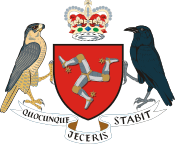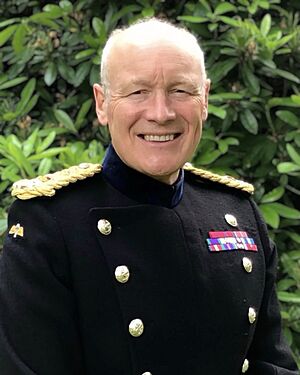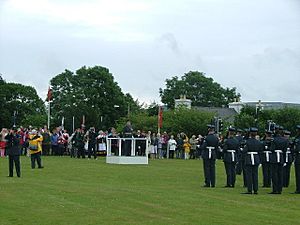Lieutenant Governor of the Isle of Man facts for kids
Quick facts for kids Lieutenant Governorof the Isle of Man |
|
|---|---|

Standard of the Lieutenant Governor
|
|
| Lieutenant Governor | |
| Style | His Excellency |
| Reports to | Lord of Mann |
| Residence | Government House, Isle of Man |
| Nominator | Isle of Man Government |
| Appointer | Lord of Mann |
| Term length | 5 years |
| Formation | 1773 |
| First holder | Henry Hope |
| Deputy | First Deemster Andrew Corlett |
| Salary | £108,208 |
| Website | Government House, Isle of Man |
| Isle of Man |
 This article is part of the series: |
|
|
|
|
|
The lieutenant governor of the Isle of Man (in Manx Gaelic: Manx: Fo-chiannoort Vannin or lhiass-chiannoort vannin) is the official representative of the Lord of Mann on the Isle of Man. The Lord of Mann is currently King Charles III. The lieutenant governor has the power to approve new laws, which is called royal assent. People refer to the lieutenant governor as "His Excellency."
It's interesting to know that no one born on the Isle of Man has ever been appointed as the lieutenant governor. However, Manx-born First Deemsters (who are like chief judges and can act as deputy governors) have temporarily filled the role. This happens when there is a gap between governors or when the lieutenant governor is away from the island.
The official home of the lieutenant governor is Government House. It is located on Governor's Road in Onchan.
In the past, the lieutenant governor had a lot of power. They were in charge of the island's courts, money, and government decisions. But over time, their role changed. They stopped being the head of the courts in 1921. They were no longer the head of the government in 1961. By 1990, they were no longer the president of Tynwald, which is the island's parliament.
Today, the lieutenant governor's job is mostly about ceremonies and representing the King. They still have some powers under the Isle of Man's laws. Sometimes, decisions are made by the governor-in-council. This means the governor makes a decision with the advice and approval of the Council of Ministers.
Contents
History of the Role
For a long time, people wondered about the exact title and powers of the island's chief executive. They also questioned if the governor's powers were paused when the Lord of Mann or a main governor was on the island. In 1877, a famous Manx lawyer named James Gell looked into this. He found records of many appointments between 1595 and 1863. It was hard to find records before 1639 because that's when they started keeping special books for these appointments.
Historically, words like "governor," "lieutenant," and "captain" all meant the same thing. They referred to the King's or Queen's representative. If the King or Queen didn't want to give a person full governor powers, they had to write it clearly in the appointment document. However, no such limits were ever recorded.
A lieutenant governor or deputy governor with full powers could do everything a main governor could.
James Gell himself served as governor twice. The first time, he was a deputy during the illness of Lord Henniker. The second time, he was an acting governor after Lord Henniker's death. This was an important difference. As acting governor, Gell had more authority than a lieutenant governor. He even had the power to appoint a lieutenant governor if he wanted to.
The term "lieutenant governor" wasn't used before 1765. Before that, they used "deputy governor." These deputy governor appointments were usually temporary, filling in when the main governor position was empty.
Lieutenant governors and deputy governors could also appoint their own deputies. This allowed them to name someone to act in their place for specific times or reasons. For example, if the governor was away or sick. This was a common practice over time.
After 1765, when the British Crown took over the island's rights (this was called the Act of Revestment), the appointments of lieutenant governors like Henry Hope (1773) were specifically for when the main governor was absent.
How the Governor is Appointed
Before 2010, the lieutenant governor was chosen by the King or Queen. This decision was based on advice from a group led by the government of the United Kingdom.
However, in July 2010, the Isle of Man government announced a new way. The next lieutenant governor would be chosen by a local group. This group included the chief minister, the president of Tynwald, and the first deemster. This new process was used for the first time a few months later to choose Sir Paul Haddacks's replacement.
Proposed Title Change
In October 2005, Tynwald (the Isle of Man parliament) wanted to change the lieutenant governor's title to "Crown Commissioner." They sent this idea to the British government to get approval from Queen Elizabeth II, who was the Lord of Mann at the time.
But many people on the island didn't like this idea. So, in April 2006, Tynwald changed its mind. They withdrew their request, and the lieutenant governor's title remained the same.
List of Governors and Deputies (Selected)
This table shows some of the people who have served as governors or deputies on the Isle of Man.
| Date appointed | Appointee name | Appointed office | By whom appointed | Remarks |
|---|---|---|---|---|
| 1 Aug 1595 | Thomas Garret (or Gerrard) | Captain | Queen Elizabeth I | First appointment during a dispute over the island's ownership. |
| 30 Mar 1639 | Ratcliffe Gerrard | Deputy governor | Lord of Mann (Lord Strange) | Acted when the main governor was away. |
| 31 May 1664 | Isaac Barrow | Governor | Lord of Mann (Charles Stanley, 8th Earl of Derby) | An unusual appointment where his deputy sometimes acted alongside him. |
| 21 Nov 1702 | Charles Zedenno Stanley | Chief governor and commander-in-chief | Lord of Mann (James Stanley, 10th Earl of Derby) | Could appoint his own deputies. |
| 14 Sep 1725 | Thomas Horton | Deputy lieutenant governor | Lord of Mann (James Stanley, 10th Earl of Derby) | |
| 9 Mar 1736 | James Murray, 2nd Duke of Atholl | Governor and commander-in-chief | Became governor after the 10th Earl of Derby died. | |
| 27 May 1746 |
|
Deputy governor | Governor Lindesay | Appointed to act when the governor was ill but still on the island. |
| 21 Jun 1765 | John Wood | Governor-in-chief and captain general | King George III | Re-appointed after the Isle of Man became part of the British Crown (Revestment). |
| 6 Aug 1773 | Henry Hope | Lieutenant governor | King George III | The first person officially called "lieutenant governor." |
| 8 Jun 1805 | Cornelius Smelt | Lieutenant governor | King George III | |
| 29 Jan 1863 | Henry Loch | Lieutenant governor | Queen Victoria | |
| Oct 1902 | James Gell, Clerk of the Rolls | Acting governor | King Edward VII | Had more authority than a lieutenant governor at the time. |
| 1902 | George Fitzroy Henry Somerset, 3rd Baron Raglan | Lieutenant governor | King Edward VII | |
| 1937 | William Spencer Leveson-Gower, 4th Earl Granville | Lieutenant governor | King George VI | |
| 1952 | Ambrose Dundas Flux Dundas | Lieutenant governor | Queen Elizabeth II | |
| 1980 | Nigel Cecil | Lieutenant governor | Queen Elizabeth II | |
| 2005 | Paul Haddacks | Lieutenant governor | Queen Elizabeth II | |
| 2011 | Adam Wood | Lieutenant governor | Queen Elizabeth II | |
| 2016 | Richard Gozney | Lieutenant governor | Queen Elizabeth II | |
| 2021 | John Lorimer | Lieutenant governor | King Charles III | The current Lieutenant Governor. |
See also
- Governors of the Isle of Man
- King of Mann
- Lord of Mann



